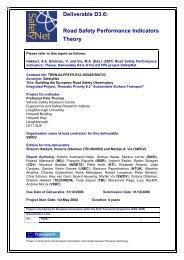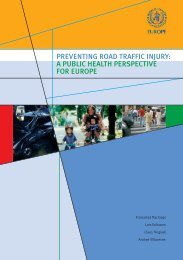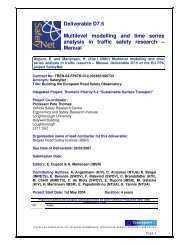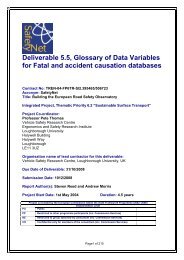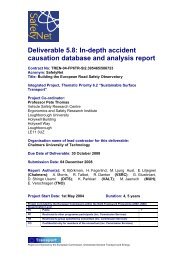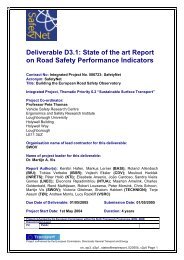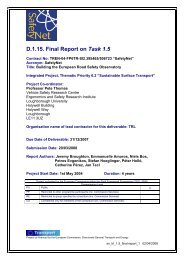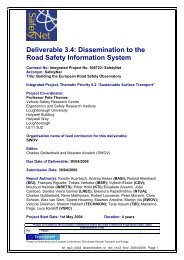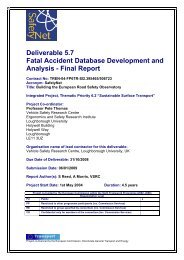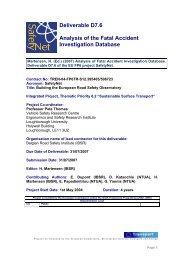Every Accident is One Too Many Every Accident is One ... - UNECE
Every Accident is One Too Many Every Accident is One ... - UNECE
Every Accident is One Too Many Every Accident is One ... - UNECE
Create successful ePaper yourself
Turn your PDF publications into a flip-book with our unique Google optimized e-Paper software.
Appendix<br />
Implemented initiatives<br />
<strong>Accident</strong>s involving alcohol<br />
A number of initiatives have been implemented with a view<br />
to reducing the frequency of drink-driving. These initiatives<br />
include local and national information activities, target<br />
specific police efforts during the summer, and treatment for<br />
drivers with convictions for drink-driving.<br />
Leg<strong>is</strong>lation<br />
A number of new Acts and regulations have been adopted<br />
and implemented as follow-up to the recommendations<br />
made by the Road Safety Comm<strong>is</strong>sion in the 1988 Action<br />
Plan. The changes made within vehicle design include a<br />
reduction in taxes on airbags, extra side-view mirrors on<br />
lorries, compulsory ABS brakes, and side screens on lorries.<br />
Initiatives to change road behaviour include the<br />
compulsory use of headlights during the day, compulsory<br />
seatbelt usage for all car passengers, and stricter<br />
regulations on the use of safety equipment for children<br />
under the age of three.<br />
Interest in local road safety efforts<br />
Local interest in road safety has proven considerable,<br />
especially during the latter half of the previous target<br />
period. More resources have been spent on local safety<br />
information activities than projected in the action plan. It <strong>is</strong><br />
now recogn<strong>is</strong>ed that local road safety work must spread<br />
like ripples on water to form the bas<strong>is</strong> for even more<br />
results.<br />
Road safety plans<br />
The 1988 action plan recommended the use of localauthority<br />
plans as an active tool in road safety efforts. The<br />
Comm<strong>is</strong>sion pointed out that local-authority planning<br />
should balance the various, more or less mutually<br />
exclusive, <strong>is</strong>sues.<br />
Resident involvement in local road safety work<br />
Three out of four of all Dan<strong>is</strong>h local authorities often<br />
involve their residents in road safety efforts, just as 70 per<br />
cent of all local authorities accord great significance to<br />
cooperation with residents. Residents’ desires constitute<br />
one of the four crucial factors l<strong>is</strong>ted when local authorities<br />
describe the activities to promote road safety. Support<br />
from state pools, highly committed local-authority staff,<br />
and active politicians are the other three factors. The two<br />
factors identified by local authorities as obstacles to local<br />
road safety efforts are lack of money and lack of<br />
manpower.<br />
Source: The Dan<strong>is</strong>h Road Directorate’s study of localauthority<br />
road safety efforts in Denmark<br />
<strong>Accident</strong> black spots<br />
Impact surveys of implemented black-spot projects show<br />
that the resultant drop in accidents corresponds to the<br />
expectations outlined in the action plan.<br />
Action plans<br />
Special action plans, such as action plans for standard<br />
four-point road junctions without traffic lights, have<br />
provided the expected, very positive and cost-effective<br />
results in terms of reducing the number of accidents.<br />
Roundabouts<br />
Roundabouts have proven to be a very safe traffic solution.<br />
Reductions in the number of injuries of between 60 and 80<br />
per cent have been measured. The effect <strong>is</strong> more<br />
pronounced for drivers than cycl<strong>is</strong>ts. As a result, there <strong>is</strong> a<br />
need for further development of roundabout design to<br />
improve cycl<strong>is</strong>t safety and ease of travel.<br />
Other measures to reduce speed<br />
Impact studies of environmentally priorit<strong>is</strong>ed thoroughfares<br />
on main primary roads have shown greater reductions in<br />
the number of accidents than projected in the action plan.<br />
Speed bumps are cheap to establ<strong>is</strong>h and prevent many<br />
accidents.<br />
In April 1999, automated speed checks were intensified on<br />
Funen and in Copenhagen.<br />
Results from speed surveys show that average speeds in<br />
areas with automated checks have dropped by up to 2.5<br />
km/hr when compared against the speeds without such<br />
checks. In addition to th<strong>is</strong>, the percentage of vehicles<br />
exceeding speed limits by more than 10 km/hr has been<br />
reduced by up to 10 per cent.<br />
These stat<strong>is</strong>tics do, however, encompass great differences.<br />
The speed limits on individual roads differ, and the greatest<br />
effect <strong>is</strong> seen on roads with a speed limit of 50 km/hr. The<br />
automated speed checks have had no d<strong>is</strong>cernible effect in<br />
Odense, whereas Svendborg saw a drop in average speeds<br />
of 2.5 km/hr, with the corresponding figure for the<br />
Copenhagen area being approximately 1 km/hr.<br />
In collaboration with the Municipality of Gladsaxe, the Road<br />
Traffic Pool funded a project on differentiated speed limits.<br />
In 1996, a zone with a local speed limit of 40 km/hr was<br />
establ<strong>is</strong>hed on a trial bas<strong>is</strong> in the neighbourhood known as<br />
Mørkhøj. A working group composed of local residents, the<br />
police, and HT selected the road junctions and roads to be<br />
focused on, and a limited number of speed bumps, etc.,<br />
were establ<strong>is</strong>hed in those areas. In conjunction with an<br />
extensive local campaign, these efforts helped reduce<br />
average speeds in the neighbourhood by between 19 and<br />
32 per cent. Th<strong>is</strong> positive result, which also led to a positive<br />
attitude towards the trial project among the local residents,<br />
42



